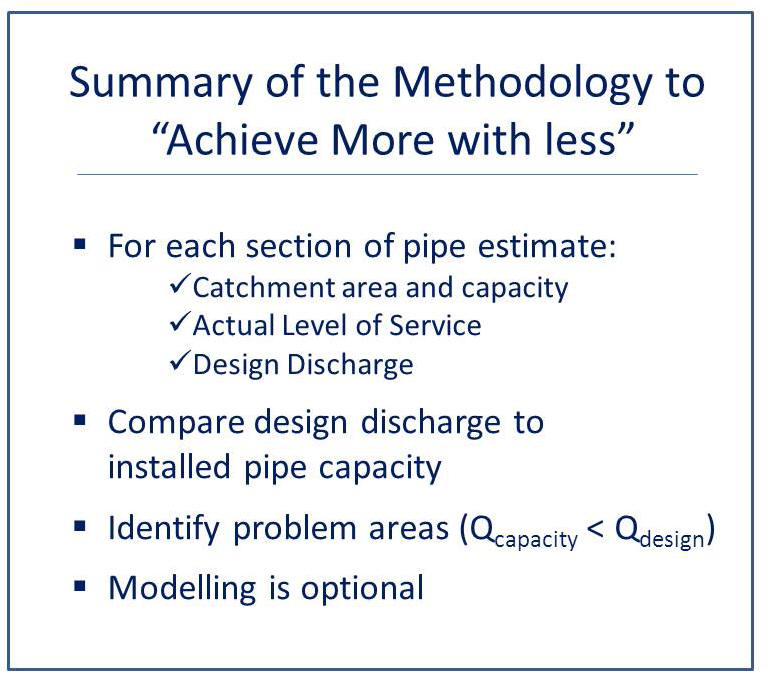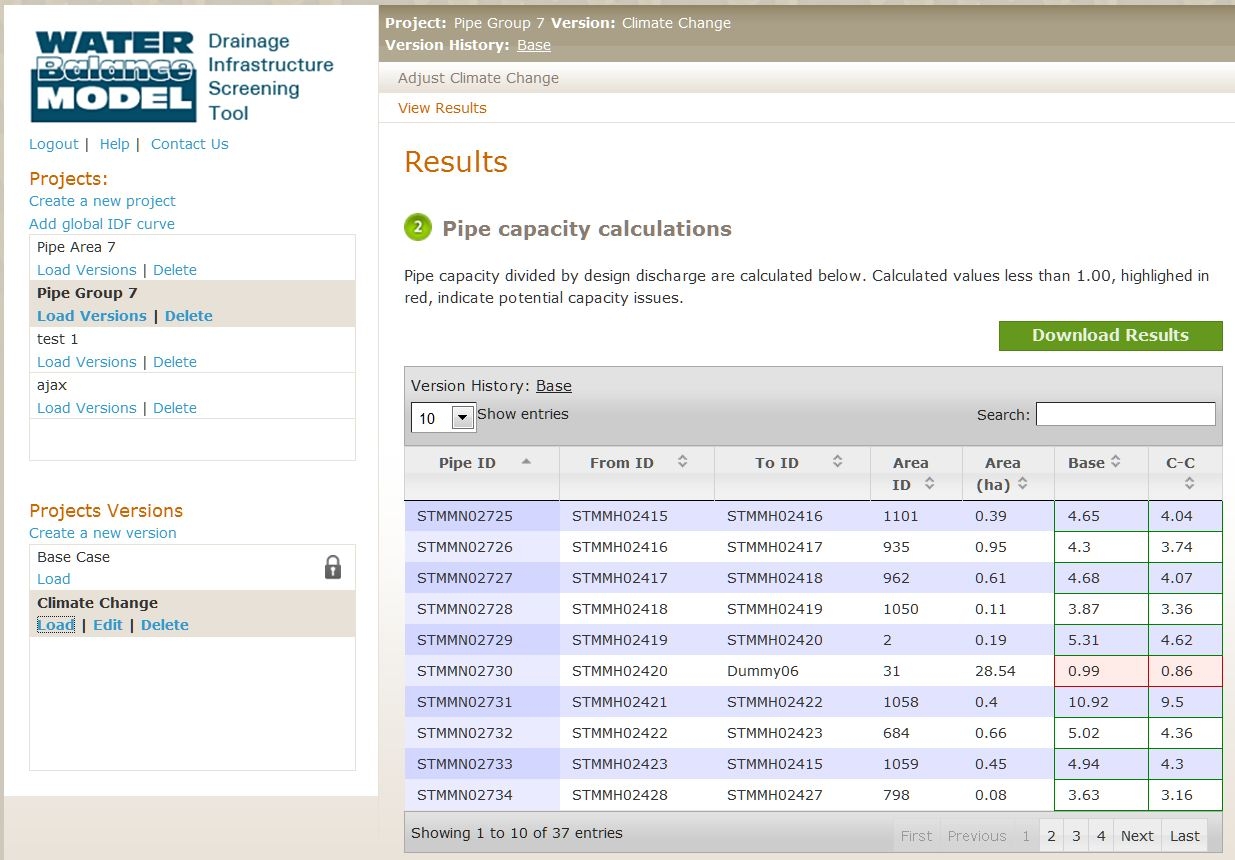British Columbia Partnership announces that Drainage Infrastructure Screening Tool is now LIVE!
Framework for Screening and Decision-Making
Many drainage conveyance systems operate without serious problems for many years. Yet many engineering studies recommend plans for pipe replacement and upsizing that would cost tens of millions of dollars, money that local governments do not have. Reliance on complex computer models and inflexible application of design standards may be having an unintended consequence.
To help local governments make informed decisions AND achieve more at less cost, the Water Balance Model Partnership has developed a web-based Drainage Infrastructure Screening Tool. This enables local governments to undertake drainage system capacity analysis without the need for intensive and expensive modelling of the storm sewer system. Four questions provide a framework for screening and decision-making:
-
What is the existing level of drainage service within the community?
-
What will be the effect of climate change?
-
What will be the effect of redevelopment?
-
What will be the effect of climate change on redevelopment?
A guiding principle is to provide an equal Level-of-Service or access to the drainage system for all properties within a drainage catchment or watershed.
Level-of-Service Methodology
A Level-of-Service (LOS) Methodology is embedded in the Drainage Infrastructure Screening Tool. This provides the means to quickly and efficiently identify weak links in a drainage system; and then budget affordable solutions. The methodology is founded on relationships that are universal.
“City of Surrey and District of North Vancouver case study experience has proven out the LOS screening methodology. The methodology saves time, effort and money,” reports Kim Stephens, Executive Director of thePartnership for Water Sustainability in BC.
 “Now, local governments can focus on what is most important AND achieve more at less cost. They can quickly and inexpensively assess drainage system performance to pinpoint any problem areas. This will help them establish capital budget priorities for detailed analysis during the design process.”
“Now, local governments can focus on what is most important AND achieve more at less cost. They can quickly and inexpensively assess drainage system performance to pinpoint any problem areas. This will help them establish capital budget priorities for detailed analysis during the design process.”
North Vancouver Demonstration Application
“The District of North Vancouver is using the screening tool to evaluate drainage infrastructure in the Hastings Creek watershed,” adds Richard Boase, the District’s Environmental Protection Officer. He is also Co-Chairof the Water Balance Model Partnership.
 ”The District’s new Official Community Plan designates new growth around the urban town centre in Lynn Valley. Because we did not have the time or resources to evaluate the entire pipe network, the screening tool allows us to undertake a basic assessment of the drainage network and highlight areas where capacity will require further study in advance of redevelopment and densification.”
”The District’s new Official Community Plan designates new growth around the urban town centre in Lynn Valley. Because we did not have the time or resources to evaluate the entire pipe network, the screening tool allows us to undertake a basic assessment of the drainage network and highlight areas where capacity will require further study in advance of redevelopment and densification.”
“The screening tool examines the pipe system that is tributary to a drainage outlet or outfall. Assessing catchments one-by-one keeps the analysis logical, simple and manageable,” continues Jim Dumont, Engineering Applications Authority for the Water Balance ModelPartnership.
 “Every pipe within each catchment is evaluated by examining the INSTALLED PIPE CAPACIY. Based on detailed modelling experience, we know that ‘problems’ fall within a narrow range. The lesson learned is that one need not model every section of pipe. This is why the screening tool compares installed pipe capacity to design discharge.”
“Every pipe within each catchment is evaluated by examining the INSTALLED PIPE CAPACIY. Based on detailed modelling experience, we know that ‘problems’ fall within a narrow range. The lesson learned is that one need not model every section of pipe. This is why the screening tool compares installed pipe capacity to design discharge.”
“The Drainage Infrastructure Screening Tool applies these lessons learned to establish priorities and make decisions. The Level-of-Service approach is inexpensive and provides relevant information for capital planning. It does this without the detailed and expensive simulation of the drainage system. The process establishes existing system capacity and then identifies those parts that do not meet this standard. These can be prioritized and entered into a capital plan.”
“By applying the Drainage Infrastructure Screening Tool, it is now quite easy for local governments to check and verify the relative impact of a changing climate on conveyance capacity. The resilience of a system depends on the capacity a system has now and how drastic future climate change might be. The tool also makes it is easy to assess the relative significance of changes in land use, in particular densification. Local governments can now consider both climate change and land use change at the same time, and with the same tool,” concludes Jim Dumont.
To Try the Screening Tool
 “Local government partners and consultants who are paid subscribers have access to this capability. To test-drive the Screening Tool, however, other local governments and/or infrastructure consultants can submit a request to partnership@watersustainabilitybc.ca for a 30-day Trial Account that has full access,” states Ted van der Gulik, Chair of the Water Balance Model Partnership.
“Local government partners and consultants who are paid subscribers have access to this capability. To test-drive the Screening Tool, however, other local governments and/or infrastructure consultants can submit a request to partnership@watersustainabilitybc.ca for a 30-day Trial Account that has full access,” states Ted van der Gulik, Chair of the Water Balance Model Partnership.
TO LEARN MORE:
In June, Jim Dumont will be demonstrating the Drainage Infrastructure Screening Tool at “sharing and learning” events hosted by the Regional District of Nanaimo on June 12.




